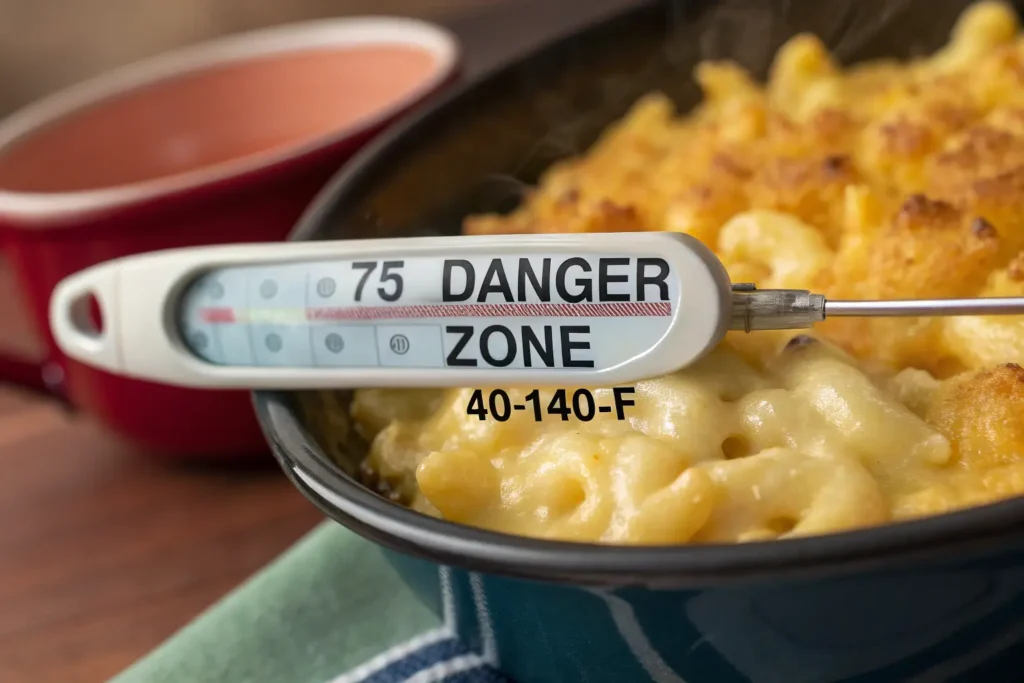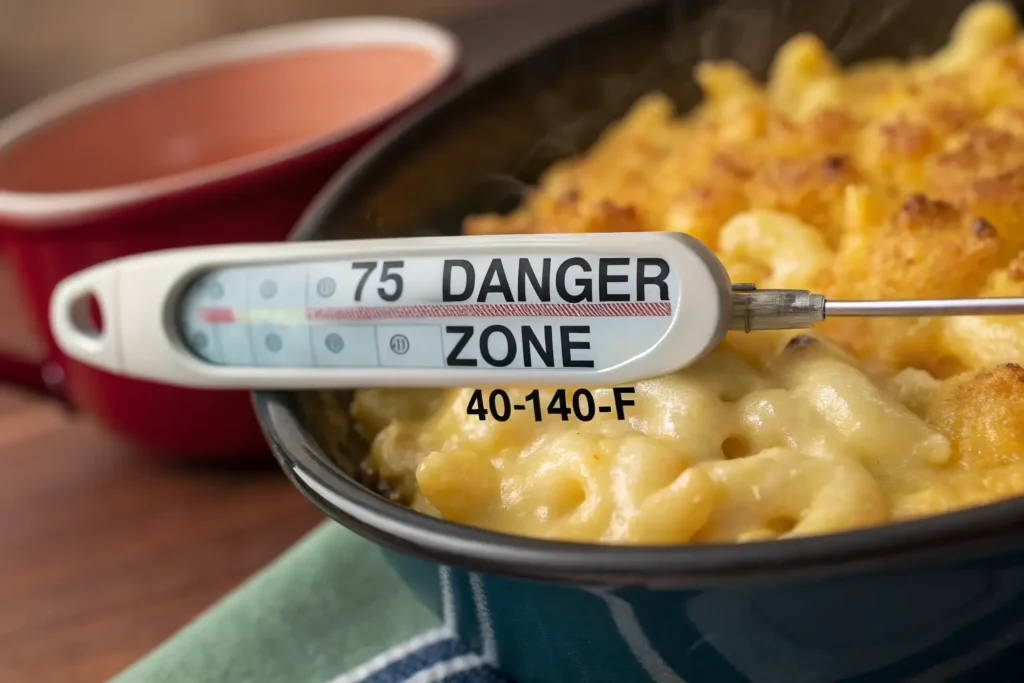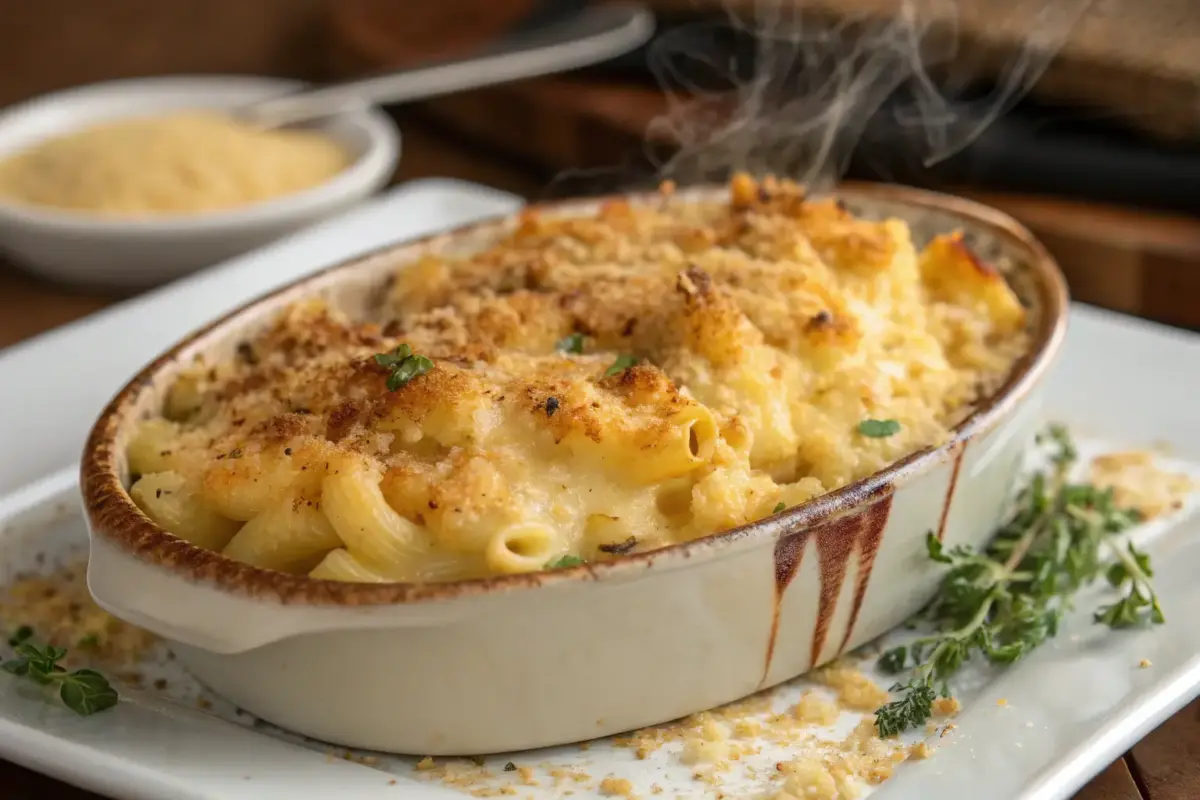Introduction
If you’ve ever wondered, “How long can cooked mac and cheese sit out?” you’re not alone. This cheesy favorite is a staple in many homes, but leaving it out too long can lead to some serious food safety concerns. Cooked mac and cheese, while delicious, is also prone to bacterial growth if it’s not handled properly. This guide will break down everything you need to know about keeping your mac and cheese safe and tasty.
The Importance of Food Safety: How Long Can Cooked Mac and Cheese Sit Out?
When it comes to cooked mac and cheese, food safety is more important than you might think. Understanding how long mac and cheese can sit out and the risks involved can help you avoid foodborne illnesses. Let’s dig into the details so you can enjoy your mac and cheese worry-free.
Understanding Bacterial Growth in Foods: Why Timing Matters
Cooked mac and cheese, like many other foods, provides an ideal environment for bacteria. Moist, warm, and nutrient-rich, it becomes a playground for harmful bacteria like Staphylococcus aureus if left out too long. That’s why understanding how long cooked mac and cheese can sit out is crucial for food safety.
Key Risks of Leaving Cooked Mac and Cheese Unattended
Leaving mac and cheese out for extended periods can lead to rapid bacterial growth. Harmful bacteria multiply quickly, especially if the mac and cheese stays in unsafe temperature ranges for too long. Knowing the answer to “How long can cooked mac and cheese sit out?” helps minimize these risks and keeps your favorite dish safe to eat.
General Rule: How Long Can Cooked Mac and Cheese Sit Out Safely?
The simple guideline for mac and cheese safety: no more than two hours at room temperature. If you’re using evaporated milk or other specialty ingredients, Why Use Evaporated Milk in Mac and Cheese? can help you make informed choices for a creamier dish.
The Two-Hour Rule for Cooked Mac and Cheese
The answer to “How long can cooked mac and cheese sit out?” is simple: no more than two hours at room temperature. After that, bacteria can grow to unsafe levels, especially if the environment is warm. Always keep this rule in mind to reduce the risk of foodborne illnesses.
Exceptions to the Two-Hour Rule
In certain situations, the time frame changes. If the ambient temperature is above 90°F—think outdoor picnics or summer barbecues—cooked mac and cheese is only safe for one hour. Following these guidelines ensures you’re always on the safe side.
Temperature Guidelines and Their Effects on Food Safety
If you’ve ever heard the phrase “the danger zone,” you know it’s not just from a song—it’s a food safety term too. Temperature plays a huge role in how long your mac and cheese stays safe to eat. Let’s break it down.
The Danger Zone for Bacteria Growth (40–140°F)

The “danger zone” refers to the temperature range where bacteria grow the fastest: between 40°F and 140°F. Once cooked food falls into this range, it becomes a prime target for bacteria to multiply. That’s why you need to keep your mac and cheese either hot (above 140°F) or cold (below 40°F).
Here’s a tip: if you’re serving mac and cheese at a buffet or party, consider using warming trays or chafing dishes to keep it hot. For cold storage, an ice bath or cooler can help during outdoor events.
Impacts of High Ambient Temperatures on Food Safety
When the weather heats up, so does the risk of food spoiling quickly. In summer or during outdoor picnics, cooked mac and cheese can become unsafe in less than an hour if left out. High temperatures speed up bacterial growth, making it critical to act fast when it comes to storage. If in doubt, toss it—your stomach will thank you later.
Storing Cooked Mac and Cheese Properly
Once your mac and cheese has cooled, follow these storage tips to maximize its shelf life. For best results, avoid using excessive amounts of cheese, as What Happens If You Put Too Much Cheese in Mac and Cheese? explains the impacts on texture and flavor.
How to Store in the Refrigerator

First things first: let your mac and cheese cool to room temperature (but not for more than two hours). Once cooled, transfer it to an airtight container. Refrigeration slows down bacterial growth, giving you about 3–5 days to enjoy your leftovers.
Best Practices for Safe Refrigeration
- Use shallow containers to help your mac and cheese cool faster.
- Label containers with the date so you know when to toss them.
- Keep your fridge set at 40°F or below for optimal safety.
Freezing Cooked Mac and Cheese
If you want to keep your mac and cheese for longer, freezing is the way to go. Properly frozen mac and cheese can last up to 2–3 months while still tasting great.
Ensuring Quality During Freezing and Thawing
- Store your mac and cheese in a freezer-safe, airtight container or heavy-duty freezer bag.
- Remove as much air as possible to prevent freezer burn.
- When you’re ready to eat, thaw it in the refrigerator overnight for best results.
Bonus tip: Portion your mac and cheese before freezing. This makes it easier to reheat only what you need, reducing waste.
Reheating Cooked Mac and Cheese
Let’s face it—nobody wants reheated mac and cheese that’s dry or rubbery. Reheating properly not only ensures food safety but also keeps that creamy, cheesy goodness intact.
Safe Reheating Techniques to Minimize Risks
When reheating mac and cheese, make sure it reaches an internal temperature of 165°F. Use a food thermometer if you’re unsure. Reheating thoroughly kills bacteria that might have developed during storage.
Microwaving is a quick option, but be sure to stir the mac and cheese halfway through to heat it evenly. For larger portions, an oven works well—just cover the dish with foil to prevent it from drying out.
How to Reheat Without Compromising Flavor
To bring your leftover mac and cheese back to life, add a splash of milk or cream before reheating. This helps restore its creamy texture. You can even sprinkle some shredded cheese on top for an extra kick.
Pro tip: If you’re reheating frozen mac and cheese, let it thaw in the fridge first. This prevents uneven heating and ensures a better texture.
Identifying Spoiled Mac and Cheese
We’ve all been there: staring at a container of leftovers in the fridge and wondering if it’s still good. Knowing how to spot spoiled mac and cheese can save you from a bad meal—or worse, food poisoning.
Common Signs of Spoilage
Trust your senses when it comes to food safety. Spoiled mac and cheese often has clear indicators that it’s no longer safe to eat.
Visual Indicators
If you notice mold, discoloration, or an unusual film on the surface, it’s time to toss your mac and cheese. Even a small spot of mold means the entire dish could be contaminated.
Unusual Odors
Fresh mac and cheese has a rich, cheesy smell. Spoiled mac and cheese, on the other hand, may smell sour or unpleasant. If something seems off, don’t take any chances.
Texture Changes
Slimy or overly dry textures are also red flags. Spoiled mac and cheese may feel sticky or have hardened areas, especially if it’s been sitting for too long.
Special Scenarios for Cooked Mac and Cheese
Sometimes, you find yourself in unique situations where food safety might be more challenging to manage. Here’s how to handle cooked mac and cheese in common scenarios.
Outdoor Picnics and Warm Weather Considerations
At picnics, keeping mac and cheese safe can be tricky. Use insulated coolers or ice packs to keep it cold if you’re not serving it immediately. If it’s a hot day, remember the one-hour rule—after that, it’s safer to toss it.
Leftovers During Holidays or Large Gatherings
During holidays, it’s easy to forget about leftovers sitting out on the buffet table. Set a timer as a reminder to refrigerate or properly store food within two hours of serving. It’s also a good idea to portion leftovers into smaller containers for quicker cooling.
Common Myths About Food Safety
When it comes to food safety, misinformation is everywhere. Let’s clear up a couple of common myths about leftovers and reheating.
Myth: Overnight Leftovers Are Always Safe
Leaving mac and cheese out overnight isn’t safe, even if the room feels cool. Bacteria grow rapidly at room temperature, making overnight leftovers a risky choice.
Myth: Reheating Always Kills Harmful Bacteria
While reheating can kill some bacteria, it doesn’t eliminate toxins that may have already formed. If food has been left out too long, reheating it won’t make it safe to eat.
Preventing Food Waste
Leftovers don’t have to go to waste! With a little planning, you can reduce waste and enjoy your mac and cheese in new and delicious ways.
Creative Ways to Use Leftover Mac and Cheese
- Turn it into a casserole by adding breadcrumbs and baking until golden.
- Mix it with cooked veggies or proteins for a hearty, one-pan meal.
- Make mac and cheese bites by rolling leftovers into balls, coating them in breadcrumbs, and frying or baking them.
Planning Portion Sizes to Avoid Excess
If you tend to make too much mac and cheese, try scaling down your recipe or using portion control. This not only reduces waste but also ensures you enjoy your meal while it’s fresh.
FAQs
Is it OK to eat macaroni and cheese left out overnight?
No, it’s not safe. Bacteria grow quickly at room temperature, and mac and cheese left out overnight is likely contaminated. It’s better to discard it.
How long does it take for cooked mac and cheese to go bad?
At room temperature, mac and cheese can start to spoil after two hours. If it’s stored in the fridge, it can last 3–5 days before going bad.
How long can mac and cheese sit out on Reddit?
The general consensus matches food safety guidelines: no more than two hours at room temperature, or one hour if it’s particularly warm.
Can I keep mac and cheese overnight?
You can keep mac and cheese overnight in the refrigerator, but not if it’s been left out at room temperature. Make sure to store it in an airtight container for the best results.
Conclusion
Knowing how long cooked mac and cheese can sit out is essential for food safety. This beloved comfort food is prone to bacterial growth if left in the danger zone (40–140°F) for more than two hours—or just one hour in hotter conditions. Proper storage in the fridge or freezer, along with safe reheating methods, ensures your mac and cheese stays fresh and safe to eat. Watch for signs of spoilage like mold, sour odors, or texture changes, and remember, when in doubt, throw it out.


1 thought on “How Long Can Cooked Mac and Cheese Sit Out? 5 Safe Guidelines You Must Follow”